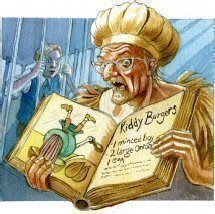How do you get a hundred hyperactive schoolchildren to sit still and shut up through seventy minutes of theatre? Trick question: it's impossible. Catherine Wheels Theatre Company accept that a young audience is going to fidget, so they've built it into their show.
The show in question is a promenade production of classic Grimm's fairy tale Hansel and Gretel at the Barbican over Christmas. Promenade may well be the ideal format for children's theatre. It keeps the audience moving, eliminating the fidgeting problem, and provides a constantly changing spectacle to keep them entertained.
The school parties certainly never seem bored or restless as friendly ushers guide them from Hansel and Gretel's woodland bungalow, through a spooky and increasingly macabre forest to the gingerbread house.
Of course everyone knows the welcoming appearance of the house is a deception, but it's still easy to empathise with Hansel and Gretel's clueless relief after fifteen minutes spent wandering through designer Karen Tennent's forest.
The trees are shadowy, insubstantial outlines - suggested by stretched tubes of gauze, lit from within by coldly twinkling fairy lights and uncomfortably reminiscent of enormous cobwebs.
As a warped version of The Teddy Bears' Picnic lures the children onwards, the imagery becomes increasingly unsettling, at least for the adults in the audience. The bones piled in the corners aren't nearly as disturbing as tableaux of children's dolls - babies and Barbies - stripped, limbs contorted, and hung in chains from the ceiling.
Traditional Grimm's horror is much more fashionable right now than supposedly child-friendly versions of their tales - and the children don't seem fazed by it, swaggering through the groves and proudly assuring one another they aren't scared at all.
Once we escape the forest into the apparent safety of the gingerbread house we find the production's other great asset: the witch.
The usual witch was ill when I saw the production, and had been replaced by the Catherine Wheels' artistic director Gill Robertson. Once she recovers, poor Helena Lymbery (and Cassie Friend, with whom she alternates the part) needs to deliver something truly stunning, or she runs the risk of being upstaged by a (presumably) last minute stand-in.
The production makes extensive use of physical clowning, to tell the story in a way that's simple to understand, to explain motivation and intent, and to lighten the tone.
The same techniques make Robertson's witch a feral creature of the forest. Dressed in dark leaves, she moves in an ape-like half crouch and beds down in a pile of furs like a sleepy cat. Her speech is a mixture of childlike mewling and bellowed, guttural commands.
The production focuses on Hansel and Gretel's responsibility for one another in the absence of a reliable parent. Hansel, the eldest and the male sibling, protects his sister from the nasties lurking in the forest; once he's caught and caged, it falls to Gretel to return the favour.
It's made clear just how quickly she has to mature in this difficult situation. She's forced to deal with a physically and vocally intimidating witch and to cook the very food that will fatten her brother for the kill, all while keeping him from falling into despair.
Yet despite all that pressure it's her ingenuity that eventually saves them both. It's not only the horror that's grown-up; the moral lesson inherent to the fairy tale is also dealt with in a grown-up way. Precisely because it doesn't treat its audience like children, Hansel and Gretel may be the perfect children's show.
Until 4th January, 2009
